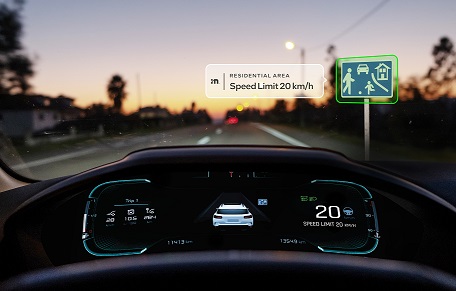Mobileye introduces vision-only Intelligent Speed Assist (ISA) device for car manufacturers
The camera-only system was developed in response to the new European Union (EU) General Safety Regulation (GSR) standards requiring automatic sensing of speed limits in all new vehicle models, without the need to rely on third-party map and GPS data.
As well as the 27 EU countries, the software, designed for Mobileye’s EyeQ platform, has been certified for use in Israel, Norway, Switzerland, and Turkey. Being a platform based system, it can be integrated with vehicles that already use EyeQ4 and EyeQ6-based ISA systems merely by updating the existing software without any new hardware requirements.
The Mobileye ISA system is expected to be integrated by a major global manufacturer into two vehicle brands for models going on sale in Europe later this year, with three others following close behind in 2024 and beyond.
According to Dr Gaby Hayon, Executive Vice President of Research and Development at Mobileye, this is a major accomplishment for the company as they’ve now proven to the industry not only that achieving GSR-compatible vision-only ISA is possible, but also that it performs better than traditional map-based approaches.
Current alternatives to the vision-only system rely on a combination of cameras and low-resolution maps to meet the EU standards, which typically brings higher cost with complexity and integration efforts, while providing less reliable performance.
The system from Mobileye incorporates several technologies that upgraded the legacy traffic sign recognition systems in order to meet GSR requirements.
These include traffic sign relevancy technology that identifies whether a speed sign is relevant to a specific lane, signature-based classification that loads the ‘signature’ of a new traffic sign to the vehicle, even for new signs that were introduced after the vehicle’s manufacture, OCR-based city entrance identification for European-style signs and advanced search engines that allow finding examples of rare signs in Mobileye’s huge clips database before integrating them into the system. In addition, it has a road-type classifier that can work out the right speed, even when traffic signs are missing, by using different cues in the scene to detect the road type.
Mobileye’s 400-petabyte database of driving footage, gathered from around the world, enables the company to rapidly meet the growing requirements of automotive safety regulators with new software designed for its existing driver-assist platforms, according to Hayon.
“After successfully surpassing GSR ISA standards during stringent testing, we look forward to collaborating with car makers to implement this lifesaving technology in Europe and beyond,” he says.
As of July 2024, all new passenger vehicles sold in the EU must meet specific GSR ISA requirements, as confirmed by rigorous testing, such as being able to detect static and dynamic message speed-limit signage across hundreds of signs, with thousands of country-specific variants, including both explicit and implicit signs, and in harsh weather and adverse lighting conditions. They must also understand temporary speed limits for road work zones, accidents, or other issues, often given by digital signage, and implicit speed limits such as city entrances.
Under the new regulation, all systems will be required to let drivers know what speed limits are in effect either actively- in which a vehicle automatically slows down gently towards a posted limit–or passively, in which the ISA system alerts drivers when they exceed posted limits.
Six independent labs across five different European countries have tested and confirmed that Mobileye’s ISA software meets or exceeds the EU’s required standards, with additional testing and certification underway.
- UK manufacturing steps up to COVID-19 crisis - April 2, 2020
- Clustering Innovation - March 12, 2020
- A Global Monitor - March 6, 2020

